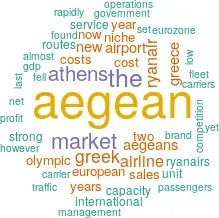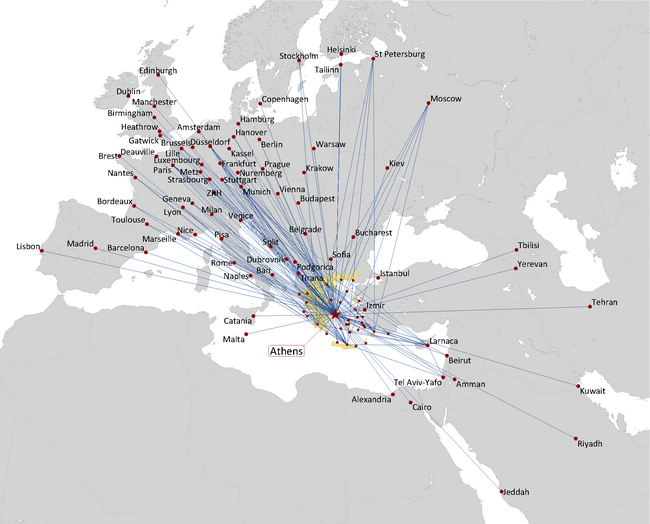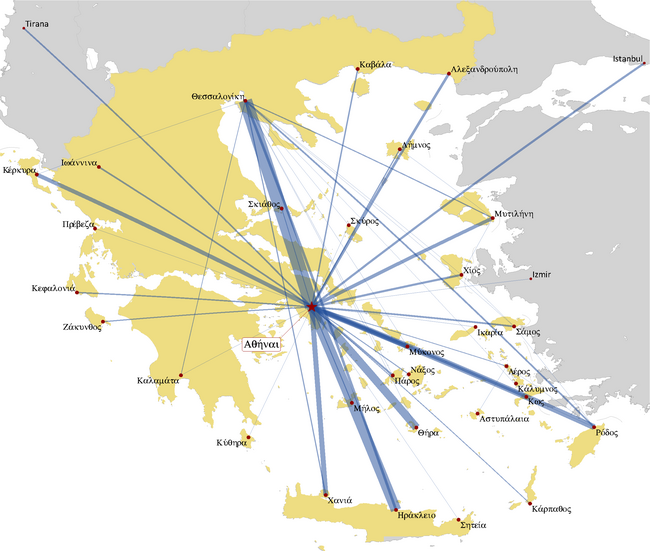Aegean: Genuine
niche carrier
May 2017


Aegean Airlines is facing greater competition from Ryanair, profit margins have slipped, but it is maintaining its status as Europe’s most successful niche airline.
Based at Athens, Aegean has found a rare niche where the hybrid airline model works. The airline has a fleet of 47 A320 Family aircraft plus 9 Q400s, two ATR42s and two Dash 100s (essential for the tiny PSO airports), carrying 12.5m passengers last year. The A320s are operated with a business class section at an overall load factor of 77%, comparable to network carriers rather than LCCs which are now averaging loads in the low 90s. Onboard service, with free food and drink in both cabins, is now superior to that offered by BA on intra-European flights.
Aegean manages to control unit costs at LCC-type levels — its 4.8€¢ per ASK ex-fuel is almost exactly the same as easyJet’s — but 40% above Ryanair’s ULCC levels. However, Ryanair’s unit costs at Athens at are likely to be significantly higher than its system average as Athens International Airport (AIA) levies some of the highest airport charges in Europe, comparable to Heathrow’s, although discounts on new routes and services have, however, been implemented following the 2013 sale by Hochtief of its 40% share to PSP, a Canadian pension fund. AIA and the Greek government (the state owns 55% of the airport) have rejected Ryanair’s offer of delivering 10m passengers and/or providing zero cost seats on some island routes if fees were to be drastically cut.
In 2016 Aegean’s revenues increased by 3.9% over 2015 to €1.02bn, but EBIT fell to €58.8m from €97.2m, and at the net level profits more than halved to €32.2m from €68.4m. The net profit margin was therefore just 3% compared to the 9% achieved in 2014 when Aegean could claim to be the second most profitable European airline, after Ryanair.
CASK fell by 5.6% to 5.05€¢ from 5.35€¢ but this was almost entirely due to the decline in fuel prices. RASK unfortunately fell by 7.8% to 6.31€¢ from 6.83€¢ . Apart from the Ryanair factor — the ULCC now accounts from 16% of seat capacity at Athens having entered the market in 2013 — Aegean itself has been expanding rapidly, taking delivery of the final seven A320ceos it had on order during the past two years and growing system ASKs by a total of 34%.
By contrast, capacity growth is expected to be minimal this year and next, 1-2% pa, affording the airline the opportunity to push up unit revenues. Management are guiding that 2017 yields are stabilising, and that RASK trends will exceed any CASK growth. HSBC analysts anticipate an improvement in net profit to €45m in 2017.
The balance sheet is strong with long term debt being just 35% of shareholders’ equity, reflecting largely Aegean’s fleet policy of concentrating on operating leases (AerCap and AWAS being the main lessors). Liquidity is also strong with cash and equivalents standing at €249m at the end of last year.
Greek context
Aegean Airlines’ origins were as a tiny turboprop operator in the 1980s flying advertising banners to entertain sunbathers on Greek beaches, then moving into scheduled and charter services in 1999, and growing steadily through the 2000s. Its prime shareholder is the Vassilakis family, and 34% of the equity is listed on the Athens stock exchange.
Until 2009 it was obliged to coexist with Olympic, the larger but grossly inefficient state-owned flag-carrier, which lurched from one financial crisis to another, surviving only because of state aid. When in 2009 the government finally came up with a formula for privatising Olympic, in effect selling off the core assets — brand and airport slots — Aegean was the strong favourite to take over the flag carrier’s operations. But the Aegean Board assumed that their company was the only candidate and did not make a formal bid, which was a mistake as the government found an alternative investor — Marfin Investment Group — and Aegean found itself in competition with a new, albeit downsized, Olympic.
However, it rapidly became clear that the Athens market would not support two similar scheduled carriers, and Aegean was by far the stronger. After protracted negotiations with the European Commission, Aegean took over Olympic in 2013 and consolidated operations over the next two years. The former flag carrier, originally set up by Aristotle Onassis, has in effect disappeared, though the Olympic brand is still used for turboprop operations in the island market.
Aegean has managed to produce profits during a period of perpetual crisis for the Greek economy. In 2008 Greek GDP peaked at $355bn; last year GDP was measured at $195bn. Currently Greece is seeking yet another loan tranche from the IMF, having yet again failed to match the conditions set for the previous loan. The country remains in a debt spiral for which the only realistic solution is a write-off.
Yet alongside the austerity and depression in Athens there are encouraging signs of new commercial dynamism as youngish executives made redundant from the private and public sectors have set up their own enterprises. Tourism is booming — arrivals were up almost 10% in 2016 — as Greece has benefitted from the collapse of the Turkish and Egyptian markets.
Moreover, Aegean is to a large extent protected by the pattern of international sales. According to an analysis by HSBC 70-80% of international tickets sales are made in other continental European countries, particularly Germany, while 20-30% are sold in Greece. The determinant of Aegean’s traffic demand is therefore GDP or disposable income in northern Europe. The UK market is slightly a different with a 50/50 split, reflecting the greater business component in this market. As for the Cyprus market, where Aegean has established a base at Larnaca, a majority of ticket sales, about 60%, are estimated to be transacted in Greece.
The large majority of Aegean’s costs are in euros or dollars and would remain in them if Greece exits the Eurozone, a scenario which is looking less likely now than it did a couple of years ago. As a rough estimate, 30% of its international ticket sales and most of its domestic sales would have to be in New Drachmae, a currency which inevitably would depreciate rapidly. Joining the Eurozone, using very dodgy national accounts, was a mistake for Greece and the EU, but leaving the Eurozone now would be catastrophic for enterprises like Aegean which are essential to the country’s fragile economic recovery.
Although Ryanair’s rapid penetration of the Greek market is a serious threat, Aegean’s competitive profile is more complicated that a simple battle between a higher cost incumbent and very low cost new entrant. As the table indicates, Aegean competes head to head with Ryanair on the dense domestic routes, where Ryanair has undoubtedly a cost advantage, and is able to adjust capacity to match widely fluctuating seasonal demand much more effectively that Aegean, though the Greek carrier does command genuine brand loyalty.
Interestingly, Ryanair is retreating slightly from the Greek market this year. It has cut frequencies by half on the key route from Athens to Thessaloniki, Greece’s second city and financial centre, because of ongoing delays to extending the runway there.
On most of the other European routes, Aegean competes against full service flag-carriers where it has a distinct advantage in terms of both unit costs and service quality. These are airport pairs which are unlikely to be targets for Ryanair. The main non-flag-carrier competition comes from Air Berlin, which should not be a problem for Aegean.
Dilemma
The dilemma facing a niche airline like Aegean is whether expand into new risky markets or stick strictly to its home base and risk its market being eroded by low cost newcomers. For Aegean this strategic issue is becoming more critical as it currently has no aircraft on order and its fleet contains a number of, by European LCC standards, elderly units: ten of its A320s are ten or more years old, and management noted a worrying escalation in maintenance costs in its Q1 2017 report.
What is clear is that the Aegean Board is rigorously focused on RoI and shareholder value, as evidenced by the share price performance. The Aegean CEO, Dimitris Georgiannis, has a strong reputation for efficiency (his background was in engineering in Germany).
As such, the speculative proposals for Aegean’s development can probably be dismissed. These include moving into long-haul: there is a perceived gap in the US-Greece market for year-round as opposed to seasonal service, but it is one that could be better served by Emirates, if the US authorities permit. Besides, as a Star alliance member Aegean has an important role feeding Lufthansa at Frankfurt and Munich. There is also the possibility of taking over Air Serbia’s operation, if Etihad pulls out, but Aegean is, rightly, very wary of the Balkan market.
An intriguing prospect for Aegean is the further development of its hubbing operation at Athens. Until relatively recently Aegean concentrated on being a point-to-point airline but its transfer traffic has more than quadrupled over the past six years to 3.2m passengers in 2016, about 26% of the total. In its annual presentation, management highlighted the multiple connecting possibilities through Athens. The airport is well suited to transfer traffic and is operating well below capacity, so it is feasible that Aegean could evolve into a significant hub operator, providing a niche alternative to THY’s mega-hub at Istanbul.
| Route | Aegean | FSCs | Ryanair | Other LCCs | Total | |
|---|---|---|---|---|---|---|
| Athens | Thessaloniki | 55% | 44% | 1% | 100% | |
| " | Heraklion | 92% | 8% | 100% | ||
| " | Santorini | 65% | 26% | 9% | 100% | |
| " | Rhodes | 64% | 36% | 100% | ||
| " | Larnaca | 69% | 31% | 100% | ||
| " | Mikonos | 77% | 17% | 6% | 100% | |
| " | London (LHR) | 44% | 56% | 100% | ||
| " | Paris (CDG) | 49% | 51% | 100% | ||
| " | Istanbul | 38% | 62% | 100% | ||
| Thessaloniki | Munich | 84% | 16% | 100% | ||
| Athens | Rome | 35% | 54% | 1% | 10% | 100% |
| " | Milan | 67% | 33% | 100% | ||
| " | Brussels | 82% | 13% | 5% | 100% | |
| " | Bucharest | 48% | 24% | 28% | 100% | |
| " | Tel Aviv | 54% | 46% | 100% | ||
| Thessaloniki | Larnaca | 53% | 47% | 100% | ||
| Athens | Frankfurt | 28% | 72% | 100% | ||
| Thessaloniki | Frankfurt | 100% | 100% | |||
| " | Düsseldorf | 49% | 51% | 100% | ||
| Athens | Madrid | 52% | 47% | 1% | 100% | |
| " | Sofia | 59% | 21% | 20% | 100% | |
| Aircraft type | In service | |
|---|---|---|
| Aegean | A320 | 38 |
| A321 | 8 | |
| A319 | 1 | |
| Total | 47 | |
| Olympic | Q400 | 9 |
| D100 | 4 | |
| ATR 42 | 2 | |
| Total | 15 |
AEGEAN BALANCE SHEET 2016 (€ millions)
| Fixed assets | 100.8 |
| Goodwill and Intangibles | 86.8 |
| Others | 38.4 |
| Non-current assets | 226.0 |
| Receivables and Prepayments | 130.7 |
| Cash | 248.5 |
| Others | 45.6 |
| Current assets | 424.8 |
| TOTAL ASSETS | 650.8 |
| Unflown revenue | 100.9 |
| Payables | 98.0 |
| Others | 120.5 |
| Current liabilities | 319.4 |
| Finance leases | 35.8 |
| Others | 51.3 |
| Long term liabilities | 87.1 |
| TOTAL LIABILITIES | 406.5 |
| Share capital | 119.2 |
| Retained profit | 95.0 |
| Others | 30.1 |
| EQUITY | 244.3 |


Note: thickness of lines directly related to number of seats operated.